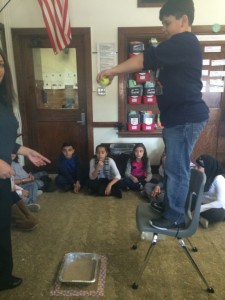Week of October 19-23
Kindergarten
Content Objective: I can demonstrate comprehension about the sense of touch by describing various objects by texture (hard, soft, bumpy, smooth, rough, sticky) and creating a hand-shape cut out with examples of different textures.
Language Objective: I can orally describe an object by feeling it and describing it’s texture.
Sentence stem :
The ____________ feels ______________.
Vocabulary: senses, touch, feel. skin, hands, feet, texture, rough, smooth, hard, soft, bumpy, sticky
S.IP.00.11 Make purposeful observations of the natural world using appropriate senses.
S.IP.00.12 Generate questions based on observations using the senses.
S.IA.00.12 Share ideas about the senses through purposeful conversation.
First Grade
Content Objective: I can demonstrate comprehension of the states of matter by observing and comparing solids ,liquids, and gases.
Language Objective: I can draw and label 3 examples of liquids and 3 examples of solids.
Vocabulary: observable, properties, matter, solid, liquid, gas, change shape
P.PM.E.2 States of Matter-Matter exists in several different states: solids, liquids, and gases. Each state of matter has unique physical properties. Solids have their own shape, but liquid and gases take the shape of the container.
*The First Graders are pouring water into various shape containers and observing how liquids easily change shape:)
Second Grade
Content Objective: I can demonstrate comprehension of mixtures by creating a Halloween Crunch mix and identifying the single substances that formed the mixture.
Language Objective: I can write to explain how the Halloween Crunch is a mixture and not a single substance.
Sentence stems:
I learned that a mixture is a _______________.
The Halloween Crunch is a mixture because_______________________.
Vocabulary: property, compare, mixture, single substance
P.PM.E.4. Material Composition-Some objects are composed of a single substance, while other objects are composed of more than one substance.
P.PM.02.41 Recognize that some objects are composed of a single substance(water, sugar, salt) and others composed of more than one substance (salt and pepper, mixed dry beans).
Third Grade
Content Objective: I can demonstrate application of motion by constructing a spinning top using different size disks and a shaft to describe motion and speed.
Language Objective: I can write to explain how I made my top spin and how I made it spin fast and slow (changed its’ speed).
Sentence stems:
I made my top spin by ________________.
I noticed that when I _________________ the top ________________________.
Vocabulary: motion, force, speed, direction, friction, disks, shaft, spinning, position, timer, seconds
P.FM.E.4 An object is in motion when its position is changing. The speed of an object is defined by how far it travels.
P.FM.03.37 Demonstrate how the change in motion of an object is related to the strength of the force acting on ii and to the mass of the object.
M.UN.03.01 Know and use common units of measurement in length, weight, and time.
Fourth Grade
Content Objective: I can demonstrate comprehension of conductors of electrical energy by testing various materials to see which are good conductors to use with my simple circuit.
Language Objectives: I can write to explain what I learned about conductors.
Sentence Stems:
I learned that conductors ___________________.
Some examples of good conductors are___________________.
Vocabulary: conductors, insulators, energy, electrical, transfer, transform, simple circuit, atoms, neutrons, protons, electrons, power source (battery), wire (path), load (bulb)
P.EN.E.51 Demonstrate how electrical energy is transferred and changed through the use of a simple circuit.
P.PM.E.5 Conductive and Reflective Properties-Objects vary to the extent they absorb and reflect light energy and conduct heat and electricity.
Fifth Grade
Content Objective: I can demonstrate comprehension of Newton’s Second Law of Motion by experimenting and measuring how far cars with different masses will travel.
Language Objective: I can draw a table and graphto show my results and explain how this activity shows Newton’s Second Law of Motion.
Sentence Stems:
The _____________ activity was an example of Newton’s Second Law of Motion.
The results from this activity showed Newton’s Second Law by _______________________.
Vocabulary: contact and non-contact forces, motion, force, mass, weight, acceleration, Newton’s Second Law of Motion, balanced force, unbalanced force, push, pull, gravitational force, relative position
P.FM.05.34 Relate the size of change in motion to the strength of unbalanced forces and the mass of the object.
P.FM.05.43 Illustrate how motion can be measured and represented on a graph.
S.IA.05.14 Draw conclusions from sets of data from multiple trials of a scientific investigation.
S.IP.05.14 Use metric measurement devices in an investigation.
S.IP.05.15 Construct charts and graphs from data and observations.
![IMG_2341[1]](https://iblog.dearbornschools.org/gruczl/wp-content/uploads/sites/1011/2015/10/IMG_23411-300x225.jpg)
![IMG_2340[1]](https://iblog.dearbornschools.org/gruczl/wp-content/uploads/sites/1011/2015/10/IMG_23401-300x225.jpg)
![IMG_2339[1]](https://iblog.dearbornschools.org/gruczl/wp-content/uploads/sites/1011/2015/10/IMG_23391-300x225.jpg)
![IMG_2338[1]](https://iblog.dearbornschools.org/gruczl/wp-content/uploads/sites/1011/2015/10/IMG_23381-300x225.jpg)
![IMG_2358[1]](https://iblog.dearbornschools.org/gruczl/wp-content/uploads/sites/1011/2015/10/IMG_23581-300x225.jpg)
![IMG_2357[1]](https://iblog.dearbornschools.org/gruczl/wp-content/uploads/sites/1011/2015/10/IMG_23571-300x225.jpg)
![IMG_2356[1]](https://iblog.dearbornschools.org/gruczl/wp-content/uploads/sites/1011/2015/10/IMG_23561-300x225.jpg)
![IMG_2355[1]](https://iblog.dearbornschools.org/gruczl/wp-content/uploads/sites/1011/2015/10/IMG_23551-300x225.jpg)
![IMG_2353[1]](https://iblog.dearbornschools.org/gruczl/wp-content/uploads/sites/1011/2015/10/IMG_23531-300x225.jpg)
![IMG_2351[1]](https://iblog.dearbornschools.org/gruczl/wp-content/uploads/sites/1011/2015/10/IMG_23511-300x225.jpg)
![IMG_2350[1]](https://iblog.dearbornschools.org/gruczl/wp-content/uploads/sites/1011/2015/10/IMG_23501-300x225.jpg)
![IMG_2347[1]](https://iblog.dearbornschools.org/gruczl/wp-content/uploads/sites/1011/2015/10/IMG_23471-300x225.jpg)
![IMG_2346[1]](https://iblog.dearbornschools.org/gruczl/wp-content/uploads/sites/1011/2015/10/IMG_23461-300x225.jpg)
![IMG_2344[1]](https://iblog.dearbornschools.org/gruczl/wp-content/uploads/sites/1011/2015/10/IMG_23441-300x225.jpg)
![IMG_2319[1]](https://iblog.dearbornschools.org/gruczl/wp-content/uploads/sites/1011/2015/10/IMG_23191-300x225.jpg)
![IMG_2318[1]](https://iblog.dearbornschools.org/gruczl/wp-content/uploads/sites/1011/2015/10/IMG_23181-300x225.jpg)
![IMG_2317[1]](https://iblog.dearbornschools.org/gruczl/wp-content/uploads/sites/1011/2015/10/IMG_23171-300x225.jpg)
![IMG_2314[1]](https://iblog.dearbornschools.org/gruczl/wp-content/uploads/sites/1011/2015/10/IMG_23141-300x225.jpg)
![IMG_2311[1]](https://iblog.dearbornschools.org/gruczl/wp-content/uploads/sites/1011/2015/10/IMG_23111-300x225.jpg)
![IMG_2310[1]](https://iblog.dearbornschools.org/gruczl/wp-content/uploads/sites/1011/2015/10/IMG_23101-300x225.jpg)
![IMG_2308[1]](https://iblog.dearbornschools.org/gruczl/wp-content/uploads/sites/1011/2015/10/IMG_23081-300x225.jpg)
![IMG_2307[1]](https://iblog.dearbornschools.org/gruczl/wp-content/uploads/sites/1011/2015/10/IMG_23071-300x225.jpg)
![IMG_2305[1]](https://iblog.dearbornschools.org/gruczl/wp-content/uploads/sites/1011/2015/10/IMG_23051-300x225.jpg)
![IMG_2303[1]](https://iblog.dearbornschools.org/gruczl/wp-content/uploads/sites/1011/2015/10/IMG_23031-300x225.jpg)
![IMG_2302[1]](https://iblog.dearbornschools.org/gruczl/wp-content/uploads/sites/1011/2015/10/IMG_23021-300x225.jpg)
![IMG_2299[1]](https://iblog.dearbornschools.org/gruczl/wp-content/uploads/sites/1011/2015/10/IMG_22991-300x225.jpg)
![IMG_2298[1]](https://iblog.dearbornschools.org/gruczl/wp-content/uploads/sites/1011/2015/10/IMG_22981-300x225.jpg)
![IMG_2291[1]](https://iblog.dearbornschools.org/gruczl/wp-content/uploads/sites/1011/2015/10/IMG_22911-300x225.jpg)
![IMG_2285[1]](https://iblog.dearbornschools.org/gruczl/wp-content/uploads/sites/1011/2015/10/IMG_22851-300x225.jpg)
![IMG_2331[1]](https://iblog.dearbornschools.org/gruczl/wp-content/uploads/sites/1011/2015/10/IMG_23311-300x225.jpg)
![IMG_2330[1]](https://iblog.dearbornschools.org/gruczl/wp-content/uploads/sites/1011/2015/10/IMG_23301-300x225.jpg)
![IMG_2329[1]](https://iblog.dearbornschools.org/gruczl/wp-content/uploads/sites/1011/2015/10/IMG_23291-300x225.jpg)
![IMG_2328[1]](https://iblog.dearbornschools.org/gruczl/wp-content/uploads/sites/1011/2015/10/IMG_23281-300x225.jpg)
![IMG_2326[1]](https://iblog.dearbornschools.org/gruczl/wp-content/uploads/sites/1011/2015/10/IMG_23261-300x225.jpg)
![IMG_2325[1]](https://iblog.dearbornschools.org/gruczl/wp-content/uploads/sites/1011/2015/10/IMG_23251-300x225.jpg)


Leave a Reply